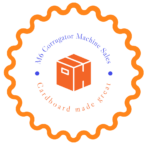Industrial Automation:
Transforming Corrugator Manufacturing Processes in 2025.
Introduction:
Industrial automation is no longer a futuristic concept—it’s the driving force behind innovation in manufacturing and production today. By seamlessly blending cutting-edge technologies like robotics, artificial intelligence, and the Industrial Internet of Things (IIoT), automation is setting new benchmarks for productivity and efficiency.
Consider this: the global industrial automation market is projected to reach $300 billion by 2026-7, with businesses increasingly adopting smart technologies to stay competitive. Companies that implement automation solutions are not just saving time and money; they’re also creating safer work environments, improving quality, and meeting sustainable manufacturing goals.
This article will delve into the world of industrial automation, exploring its types, technologies, applications, and future trends. Whether you’re an industry expert or a curious newcomer, this comprehensive guide will provide insights backed by expertise, experience, and industry authority. Get ready to uncover how automation is reshaping industries and creating a brighter, more efficient future!
What Is Industrial Automation?
- Definition of industrial automation
- Key components: sensors, controllers, and actuators
- Evolution from manual to automated systems
- Benefits: efficiency, cost savings, and consistency
Types of Industrial Automation
- Fixed automation: Assembly lines for mass production
- Programmable automation: Adaptable machinery for batch production
- Flexible automation: Systems that handle product variety
- Integration of hybrid models for modern industries
Key Technologies Driving Industrial Automation
- Role of AI and machine learning in automation
- Robotics: Collaborative robots (cobots) and industrial robots
- Industrial IoT (IIoT) and its impact on connectivity
- Automation software: SCADA, MES, and ERP systems
Applications of Industrial Automation Across Industries
- Automotive manufacturing and assembly
- Food and beverage production
- Pharmaceuticals and chemical processing
- Logistics and supply chain optimization
Advantages of Industrial Automation
- Improved productivity and reduced downtime
- Enhanced product quality and consistency
- Worker safety and reduced, workplace hazards
- Cost savings over the long term
Challenges in Implementing Industrial Automation
- High initial investment costs
- Workforce upskilling and resistance to change
- Cybersecurity risks in connected systems
- Maintenance and updates of automation technology
The Future of Industrial Automation in 2025 and Beyond
- Smart factories and Industry 4.0 advancements
- Trends in sustainable automation practices
- The role of edge computing and AI-driven analytics
- Predictions for the industrial automation market growth.
Conclusion:
Industrial automation represents the convergence of technology, innovation, and industrial expertise. It’s not just about replacing human effort; it’s about amplifying capabilities, ensuring consistent quality, and paving the way for more sustainable practices.
As we step into 2025 and beyond, the adoption of smart factories, advanced robotics, and AI-driven solutions is accelerating, empowering industries to meet rising demands while overcoming global challenges. Businesses that invest in automation not only future-proof their operations but also gain a competitive edge in a rapidly evolving market.
Are you ready to take-the-leap, into the future of manufacturing? Embrace the power of industrial automation today and position your business for long-term success. The tools, technologies, and strategies are here—all you need is the vision to implement them!
Investment in Modern Corrugtors


